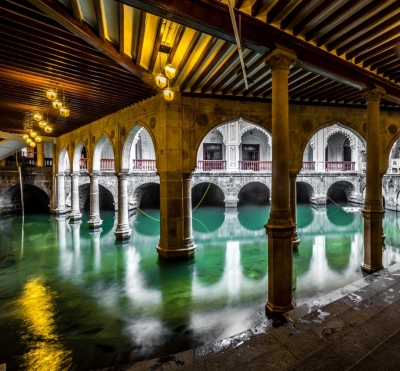By Quaid Najmi
Mumbai– As the city continues in spells of the Covid-19 pandemic lockdown, the management of the historic Juma Masjid in south Mumbai — once graced by the late King Saud bin Abdulaziz al Saud of Saudi Arabia — have embarked upon an unusual mission — clean-up of the ancient pond inside the mosque.
A team of workers got onto the task from Monday, descended in the 10-feet-deep pond, caught all the goldfish, silverfish and turtles and transferred them to a temporary fish tank, emptied up the misty greyish-green water, and launched a thorough weeklong cleaning operation, along with minor repairs on the floor.
“This is the first time in 12 years that we are doing this, taking advantage of the lockdown when few Muslim faithful turn up for prayers here We do a clean-up at intervals of several years, depending on the requirements,” the Juma Masjid’s Chief Mufti Ashfaq Kazi told IANS.
“Soon, the lockdown may be lifted. At that time, we don’t want any faithful to be at any kind of risk, so we decided to spruce-up this ancient pond,” Juma Masjid of Bombay Trust (JMBT) Chairman Shuaib Khatib told IANS.
It was in 1954 that King Saud visited this mosque during an official tour to India, the Pakistani Cricket Team was given lodging and boarding during its first tour of India in 1960-61 at the Mohammediya High School in its premises, while the late Prime Minister Indira Gandhi maintained close contacts with the Juma Masjid trustees.
Fed by natural underground fresh-water springs, the pond harbours an interesting tale in its depth — it belonged to a wealthy Bombay landlord Momin Sahab who sold it to a group of citizens in 1775 for Rs 12,000, said Kazi.
“Thereafter, the work on the sprawling mosque started around and above the same pond. After 27 years, the mosque opened for its first-ever ‘Juma Namaaz’ (Friday Prayers) in 1802,” Kazi said.
The quadrangular mosque created history as the first Juma Masjid of Bombay funded by the people, where Friday prayers and all other major festivals like Eid were celebrated for 220 years without a break — barring 2020 and 2021 — on its premises that can accommodate around 6,000 people for each namaaz.
For buying the pond, constructing the magnificent mosque with 2 minarets, and acquiring the adjoining property where there is a cemetery, the then ‘sethjis’ (wealthy businessmen) like Hamzabhai, two brothers Nathu Patel and Bhikhan Patel, contributed the lion’s share, while ordinary folks gave even One Paise — which had a significant value in those days — to the cause, Kazi added.
Later, a big businessman, Mohammed Ali Roghe-I donated a sum of money in memory of his young daughter who had died suddenly, to build the first floor of the Juma Masjid, while his son Mohammed Ali Roghe-II kept contributing till it was completed in 1835.
“The mosque is made of bricks and stones, the main eastern gate opens into a courtyard that leads to the ancient tank, now bound with steps and embankments where the faithful perform the ‘wazu’ (ritual ablutions) before the prayers,” explained Khatib.
Though the Juma Masjid opened in 1802, subsequent additions were made in the form of 16 black stone arches above the pond which support the mosque foundations and the upper story held by five rows of wooden pillars, each having a receptacle for sacred books, built in 1874 for Rs 75,000, and later in 1898, large windows created in the east, north and south walls.
Once a humble ‘madrassa’ started around 1960, the school is now an Urdu-English medium institution imparting modern education to 600 boys-girls, till Class 10.
The mosque also has a 150-year-old library with more than 16,000 Islamic books, including 1,500 texts which are rare manuscripts, several dating back to the 7th century which are now digitized and preserved with utmost care, Kazi said.
After the clean-up, Khatib will have a surprise in store for the faithful — an oxygen tank fitted inside the pond so that the water remains perpetually clean and purified — to prevent any ill-effects of the Coronavirus or its future mutants! (IANS)














